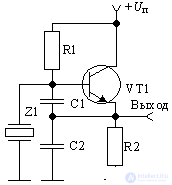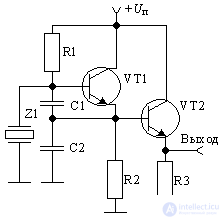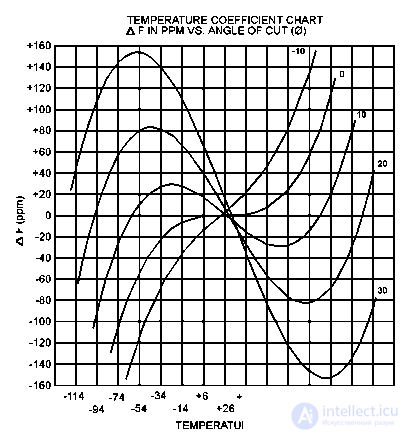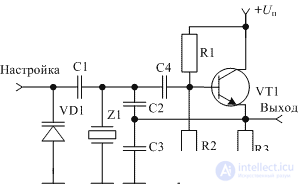Lecture
At present, when developing electronic equipment, great attention is paid to the stability of its characteristics. Mobile radio communications, including cellular communications, are no exception. The main condition for achieving stable characteristics of electronic equipment is the frequency stability of the master oscillator.
As a part of any electronic equipment, including receivers, transmitters, microcontrollers, there are usually a large number of generators. Initially, it was necessary to apply efforts to ensure the stability of the frequency of all generators. With the development of digital technology, people have learned to form the oscillation of any frequency from a single initial frequency. As a result, it became possible to allocate additional funds to increase the frequency stability of a SINGLE generator and thereby obtain a number of frequencies with very high stability. This frequency generator is called the reference oscillator.
Initially, special constructive methods were used to obtain stable oscillations of LC generators:
Thus, it was possible to achieve stability of the frequency of the reference oscillator 10–4 (at a frequency of 10 MHz, the frequency deviation was 1 kHz)
At the same time, work was carried out on the application of completely different methods for obtaining stable oscillations. Were developed string, tuning fork, magnetostriction generators. Their stability reached very high values, but at the same time the size, complexity and price prevented their wide distribution. A revolutionary breakthrough was the development of generators using quartz resonators. One of the most common schemes of quartz oscillators, made on a bipolar transistor, is shown in Figure 1.

Figure 1. Scheme of a quartz oscillator on a bipolar transistor
In this circuit of the reference generator, the balance of amplitudes is provided by the transistor VT1 and the balance of the phases - by the circuit Z1, C1, C2. The generator is assembled according to the standard scheme of the Kolpitz. The difference is that instead of the inductor, a quartz resonator Z1 is used. It should be noted that in this scheme it is not necessary to use emitter stabilization to ensure the stable operation of the circuit. Often it turns out to be quite enough and collector stabilization of the operating mode of the transistor. A similar scheme is shown in Figure 2.

Figure 2. Diagram of a quartz oscillator with collector stabilized mode
The circuits of the quartz oscillators shown in Figures 1 and 2 allow us to obtain the frequency stability of the reference oscillation of the order of 10–5. The short-term stability of the oscillations of the reference oscillator is most influenced by the load. With the presence of extraneous oscillations at the output of the reference generator, the capture of its oscillations is possible. As a result, the crystal oscillator will produce oscillations with the frequency of interference. In order for this phenomenon not to manifest itself in the reference oscillator, an amplifier is usually placed at its output, the main purpose of which is not to miss external oscillations in a quartz oscillator. A similar scheme is shown in Figure 3.

Figure 3. Scheme of a crystal oscillator with decoupling of frequency-generating circuits from the output of the circuit
An equally important parameter, which largely determines the phase noise of the generator (for digital circuits — jitter of the synchronization signal), is the supply voltage, so the reference quartz oscillators are usually powered from a highly stable low-noise voltage source and filter the RC or LC power supply by chains.
The greatest contribution to the frequency instability of a quartz oscillator is made by the temperature dependence of the resonant frequency of the quartz resonator. In the manufacture of resonators of quartz reference oscillators, AT cuts are usually used, providing the best frequency stability depending on temperature. It is 1 * 10–5 (10 million or 10 ppm). An example of the dependence of the frequency of quartz resonators with an AT-cut on the temperature at various cut-off angles (step of changing the cut-off angle 10 ') is shown in Fig. 4.

Figure 4. The dependence of the frequency of quartz resonators with AT-cut on temperature
The frequency instability of 1 * 10–5 is sufficient for most electronic devices, so quartz oscillators without special measures to improve frequency stability are used very widely. Reference oscillators with quartz stabilization without additional frequency stabilization measures are called XO.
As can be seen from Figure 4, the dependence of the tuning frequency of a quartz resonator with an AT cutoff on temperature is well known. Moreover, this dependence can be removed experimentally for each specific instance of the quartz resonator. Therefore, if you constantly measure the temperature of a quartz crystal (or the temperature inside the quartz reference oscillator), then the generation frequency of the reference oscillator can be shifted to the nominal value by increasing or decreasing the additional capacitance connected to the quartz resonator.
Depending on the frequency control scheme, such reference oscillators are called TCXO (quartz oscillators with thermal compensation) or MCXO (quartz oscillators with microcontroller control). The frequency stability of such quartz reference oscillators can reach 0.5 * 10–6 (0.5 ppm or 0.5 ppm)
In some cases, the reference oscillators provide for the possibility of adjusting the nominal frequency of generation within small limits. Frequency adjustment is carried out by the voltage applied to the varicap connected to the quartz resonator. The range of the generator frequency adjustment does not exceed fractions of a percent. This generator is called VCXO. A part of the reference generator circuit (without a thermal compensation circuit) is shown in Figure 5.

Figure 5. Quartz oscillator with adjustable frequency external voltage (VCXO)
Currently, many companies produce reference generators with frequency stability up to 0.5 * 10–6 in small-sized packages. An example of a drawing of such a reference generator is shown in Figure 6.

Figure 6. The appearance of the reference crystal oscillator with temperature compensation
Comments
To leave a comment
Devices for the reception and processing of radio signals, Transmission, reception and processing of signals
Terms: Devices for the reception and processing of radio signals, Transmission, reception and processing of signals